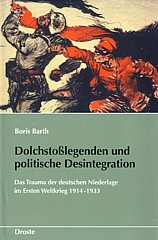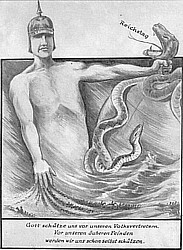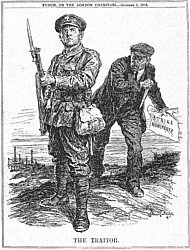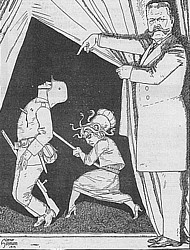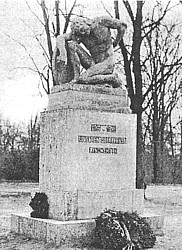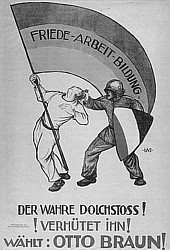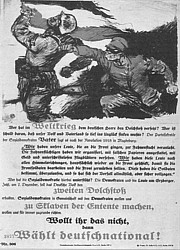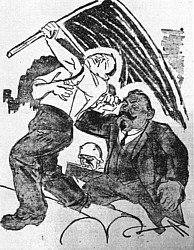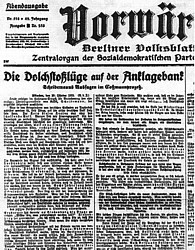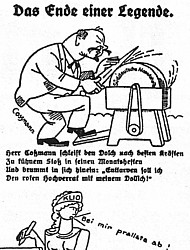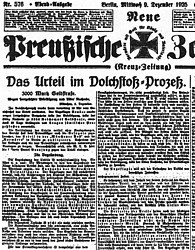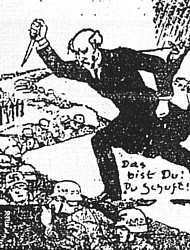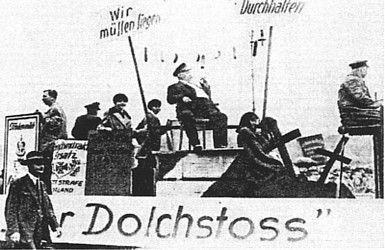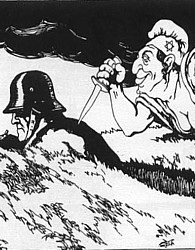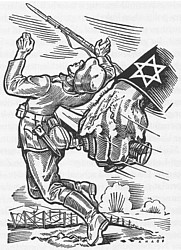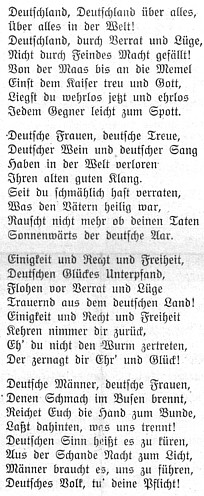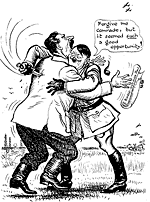| Harold Marcuse, review for H-German, (2006), e-mailed to list Dec. 4, 2006; H-Net post
Boris Barth, Dolchstosslegenden und politische Desintegration:
Das Trauma der deutschen Niederlage im Ersten Weltkrieg, 1914-1933.
(Düsseldorf: Droste, 2003). ISBN 3770016157, 625 Seiten, 49,80
EUR.
More a History of Political
Fragmentation than of a Symbol
I agreed to review this book thinking that I would read a detailed reception
history of a potent propaganda "legend" that destabilized the Weimar republic
and mobilized enmity against Jews and Communists. This book is both more
and less. Boris Barth's _Habilitation_ at the University of Konstanz,
a massive tome of 560 densely printed text pages including 3340 well-researched
footnotes, draws on a wide array of primary and secondary sources to recapitulate
and reassess our understanding of the transition from the _Kaiserreich_
to the Weimar Republic. The stab-in-the-back legends (note the plural)
of the title is used as a metaphor for the fragmentation of society into
antagonistic groups blaming each other for the catastrophe of the Great
War. The bulk of the book is devoted to a narrative of the deterioration
of the military situation during the war, and then of the group discourses
that developed from 1918 to 1921. Explicit discussions of various groups'
stab-in-the-back allegations resurface periodically, with the general
historical narrative serving admirably as a background foil against which
readers can assess the veracity of those "legends."
My main criticisms of the book are that it is so difficult to extract
important interpretative points from the densenarrative, and that the
title is somewhat misleading. Aside from the book's primary scope of 1917-1921,
it has little to say about _Dolchstosslegenden_.
| [1] Joachim Petzold, _Die
Dolchstosslegende: Eine Geschichtsfaelschung im Dienste des deutschen
Imperialismus und Militarismus_ (Berlin, 1963); Friedrich Freiherr
Hiller von Gaertringen, "'Dolchstoss'-Diskussion und 'Dolchstosslegende'
im Wandel von vier Jahrzehnten," in: Waldemar Besson and F. Frhr.
Hiller v. Gaertringen (eds.), _Geschichte und Gegenwartsbewusstsein:
Festschrift fuer Hans Rothfels zum 70. Geburtstag_ (Goettingen
1963), 122-160. (to note 4) |
The bulk of Barth's material about that political catchphrase is openly
taken from the secondary literature, adding little of substance to results
already published in Joachim Petzold's 1961 East German dissertation or
Friedrich Freiherr Hiller von Gaertringen's 1963 article.[1] Barth only
summarily mentions the parliamentary subcommittee formed in October 1919
to investigate the reasons for the loss of the war (499-506), and he mentions
only in passing Hindenburg's November 19, 1919 prepared statement to that
subcommittee, which was crucial for the national dissemination of the _Dolchstoss_
image (336f).
However, rather than belaboring what this book does
not do, let me attempt summarize and assess its main interpretative points,
a couple of which are truly innovative.
The first four of nine chapters examine the last two years of the war.
First Barth retraces in detail how a discursive dichotomy developed between
the 'battle front' and the 'homeland' (_Front_ and _Heimat_).
He argues that the latter, which by 1918 was referred to as the "_Heimatfront_",
finally collapsed in the summer of 1918. This terminological dichotomy
enabled army leaders to conceptualize their failure to completely harness
the resources of civilian society to the war effort. Chapters
two through four narrate: 1) the deterioration
of the military situation, 2) how patriotic cultural
trend-setters (the _Bildungsbuergertum_, represented primarily
by the professoriate and the Protestant clergy) rhetorically deluded themselves
about the possibility of defeat, and 3) how the structure
of society adapted to the exigencies of war mobilization by morphing from
an imperial monarchy into a populist parliamentary democracy with monarchist
symbolic trappings. This is all just prelude to what many groups later
conceptualized (or misconceptualized) as stabs-in-the-back.
A brief passage in chapter three is key for those interested in the first
use of the term "_Dolchstoss_" (144-148). Barth discusses three
key sources:
| [2] On the proposed levée
en masse, see Michael Geyer, "Insurrectionary Warfare: The German
Debate about a _Levée en Masse_ in October 1918,"
_Journal of Modern History_ 73(2001), 459-527. |
- Friedrich Meinecke's October-November 1918 writings on the idea of
a levée en masse[2];
- a June 11, 1922 newspaper article, in which Meinecke attempted to
trace the roots of the _Dolchstosslegende_;
- and a liberal _Volksversammlung_ in the Munich Loewenbraeu-Keller
on November 2, 1918, in which Ernst Mueller-Meiningen, a member of the
Progressives in the Reichstag, used the term to exhort his listeners
to keep fighting:
'As
long as the front holds, we damn well have the duty to hold out in
the homeland. We would have to be ashamed of ourselves in front of
our children and grandchildren if we attacked the battlefront from
the rear and gave it a dagger-stab.'
("_Solange die aeussere Front aushaelt, haben wir die verdammte
Pflicht zum Aushalten in der Heimat. Wir muessten uns vor unseren
Kindern und Kindeskindern schaemen, wenn wir der Front in den Ruecken
fielen und ihr den Dolchstoss versetzten._")
This statement was greeted by sustained, thunderous applause, in contrast
to the speech by Kurt Eisner of the radical socialists, who was booed
and had to leave the beer hall.
In the second half of the book Barth documents how various stab-in-the-back
legends developed independently within different groups and "submilieus"
during and after the November 1918 revolution. Ultimately, he argues,
these legends merged into a unifying symbol for the right wing after 1925.
Chapter five documents the emergence of two "stereotypes"
during the demobilization and transition in November-December 1918. On
the one hand the returning troops were welcomed home with slogans about
being "undefeated in the field"--a notion brought to national prominence
by Friedrich Ebert in his December 10, 1918 speech to the returning troops
at Brandenburg Gate in Berlin (214f):
'Be welcomed wholeheartedly, soldier-comrades, worker-comrades,
citizens [_Kameraden, Genossen, Buerger_]. No enemy overcame
you. Only when the opponent's superiority in people and materiel became
ever more oppressive did we give up the fight. And especially in the
face of your heroism it was [our] duty not to demand senseless additional
sacrifices from you. ... With heads held high you can return.'
Ebert's unknowingly loaded use of "we" and "you" was duly noted in the
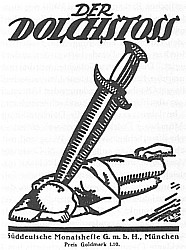 newspaper
reports--a crucial fact for which Barth surprisingly relies on the secondary
literature. On top of Ebert's unintentional self-inculpation, some members
of the radical left, most notably Emil Barth of the USPD, claimed hyperbolically
that their long-standing opposition to the war and systematic preparation
of revolution had caused the fall of what we would today call the military-industrial
complex. Emil Barth's claim resurfaced prominently in the 1925 Munich
Stab-in-the-Back Trial (223), in which the editor of the bourgeois-nationalist
_Sueddeutsche Monatshefte_ successfully sued an SPD newspaper
editor who had called him a history-falsifier because the _Monatshefte_
blamed the SPD for the loss of the Great War (510-517). In addition to
Emil Barth's proud claim of responsibility for bringing the imperial system
down, another variant of the legend propagated by the far left blamed
the SPD for having betrayed the working class by supporting the war. newspaper
reports--a crucial fact for which Barth surprisingly relies on the secondary
literature. On top of Ebert's unintentional self-inculpation, some members
of the radical left, most notably Emil Barth of the USPD, claimed hyperbolically
that their long-standing opposition to the war and systematic preparation
of revolution had caused the fall of what we would today call the military-industrial
complex. Emil Barth's claim resurfaced prominently in the 1925 Munich
Stab-in-the-Back Trial (223), in which the editor of the bourgeois-nationalist
_Sueddeutsche Monatshefte_ successfully sued an SPD newspaper
editor who had called him a history-falsifier because the _Monatshefte_
blamed the SPD for the loss of the Great War (510-517). In addition to
Emil Barth's proud claim of responsibility for bringing the imperial system
down, another variant of the legend propagated by the far left blamed
the SPD for having betrayed the working class by supporting the war.
The preceding paragraph's information density reflects a characteristic
of Barth's book: It revels in detail to the point of obfuscation. A key
event such as the Munich Stab-in-the-Back Trial is casually mentioned
in chapter five, but not explained until 300 pages later.
Similarly, the book features a huge cast of characters, sprinkled throughout
with abandon, but rarely characterized or reintroduced.
Chapter six convincingly presents several important
new interpretations, which, however, are only tangentially related to
the _Dolchstoss_ concept. Barth's overarching argument is that
various stab-in-the-back legends developed independently in the army officer
corps, among Free Corps in the 1920 Ruhr battles, and among Free Corps
trying to hold the Baltic region for Germany. The officer corps 'had no
mental categories' with which to understand why their troops simply went
home once the demobilization trains crossed the border, so they attributed
this behavior to the corrosive influence of the revolutionary _Heimat_
(231). Then Barth notably reinterprets the Ruhr war following the January
1920 Kapp-Putsch as resistance not by revolutionary workers, but by fed-up
combat veterans against their former military establishment attempting
to return to power (279-283).
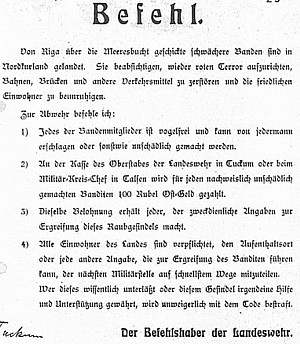 The
striking brutality of the Baltic _Landwehren_, who felt back-stabbed
when the Ebert government cut off their supplies and ordered them to withdraw
under the Versailles terms, prefigured the ferocity with which Jews in
the region were hunted two decades later. An April 1919 order by the _Landwehr_
commander in Riga stated that: any red 'bandit' could be killed by anyone,
a 100 rubel reward would be paid for each killing or for information leading
to capture, and anyone failing to report any information about such 'riff-raff'
would be executed (260, ill. p. 296). Over 3000 men were killed in Riga
in a matter of weeks, with massacres of 500 and 200 documented in other
towns (265f). Once back in the Reich, many of these troops exhibited 'nihilistic'
and politically 'autistic' behavior, in spite of Defense Minister Noske's
generous efforts to reintegrate them. The
striking brutality of the Baltic _Landwehren_, who felt back-stabbed
when the Ebert government cut off their supplies and ordered them to withdraw
under the Versailles terms, prefigured the ferocity with which Jews in
the region were hunted two decades later. An April 1919 order by the _Landwehr_
commander in Riga stated that: any red 'bandit' could be killed by anyone,
a 100 rubel reward would be paid for each killing or for information leading
to capture, and anyone failing to report any information about such 'riff-raff'
would be executed (260, ill. p. 296). Over 3000 men were killed in Riga
in a matter of weeks, with massacres of 500 and 200 documented in other
towns (265f). Once back in the Reich, many of these troops exhibited 'nihilistic'
and politically 'autistic' behavior, in spite of Defense Minister Noske's
generous efforts to reintegrate them.
Chapter seven offers an intellectual history of early
1920s right-wing _Vergangenheitsbewältigung_ (my term) among
conservative monarchists, army generals, Protestant clergy, and voelkisch
and pan-German groups. Barth concludes that the latter two submilieus
'autistically' (one of his favorite adjectives) adopted the justifications
of the former three multipliers. Thus in the stable phase of the Republic
they espoused a nihilism directed against the new social order, without
offering any vision to supplant it.
Chapter eight continues in this vein by looking more
closely at the educated bourgeoisie (primarily professors in various disciplines),
showing how revanchist stab-in-the-back ideas gained traction, especially
among student activists, while liberal voices remained ineffectual. By
the late 1920s, Barth argues, professors who had served at the front came
into conflict with frustrated students who saw themselves as warriors.
Such students bought into the stab-in-the-back rhetoric of the older university
establishment, which had not experienced war, but only dissolution in
the _Heimat_.
Chapter nine, finally, begins to take the narrative
into the later 1920s. It begins with the argument that there were no consensual
symbols to memorialize the war, drawing cursorily on a curious mix of
primary materials from the _Bundesarchiv_ and the already rich
secondary literature on the topic. The next section, on the 'judicial
fights about memory,' covers some of the most crucial events that undergird
Barth's central thesis about how allegations of blame for defeat led to
the political fragmentation of society. However, especially in comparison
to the lavish detail of earlier chapters, the narrative here is tantalizingly
brief, but the interpretations quite explicit. The third section covers
the evolving relationships to stab-in-the-back legends by organizations
such as the _Stahlhelm_, _Reichsbanner_, and _Jungdeutscher
Orden_, as well as in the war literature generally and by various
writers such as Juenger, Remarque, Zweig and Brecht. A separate section
is devoted the Hitler and the Nazis' use of _Dolchstoss_ vocabulary
(such as 'November criminals'), first to justify 'cleaning up' internal
German dissent, then to vilify specific groups such as Bolsheviks and
Jews.[3]
| [3] Indicative of Barth's reliance
on secondary materials about the _Dolchstoss_ itself is his
discussion of _Mein Kampf_. On pp. 543f, notes 343 and 344,
Barth misunderstands Petzold, who actually argues that Siegfried Kaehler's
1946 claims about _Mein Kampf_ are utter distortions. |
Barth did a prodigious amount of primary research in the papers of organizations,
political and intellectual figures, and periodical literature, as well
as in published primary and secondary material. While his inclusion of
even tangential examples in the main text give the book great evidentiary
weight, Barth is not especially successful in drawing out the broader
implications of his research. For instance, although he explicitly disavows
the thesis of a Weimar democracy doomed to failure from the start (4),
seen through this book's lens of inexorably blossoming stab-in-the-back
legends, there is no indication of how the Republic might have withstood
the agitation from both right and left. The book would also have benefited
from a more explicit discussion of the extent to which the stab-in-the-back
myth was a crucial link between Germany's defeat in the Great War and
its pursuit of another European war. Hitler was undoubtedly personally
shaped by the one-two punch of Germany's defeat and revolution, but he
was also driven by positive visions that went well beyond trying to overcome
the trauma of defeat in the Great War.
This point about links between the two world wars leads me to the first
of two unusual lapses in this otherwise exhaustively researched work.
First, in spite of the obvious importance of German war aims for the war
guilt/responsibility discussion, there is nary a mention of Fritz Fischer,
his students, or the debate Fischer's _Griff nach der Weltmacht_
triggered after1961. This omission is especially striking in Barth's discussion
of the War Guilt Department (499ff). I am at a loss to explain it, especially
in light of the fact that the foundational secondary works on the _Dolchstosslegende_
were both published in 1963 during the Fischer debate.[4]
Second, as Patrick Krassnitzer pointed out in his review for H-Soz-u-Kult,
in spite of Barth's emphasis on the symbolic importance of the _Dolchstoss_,
Barth makes no mention of the gendered aspect of its symbolism.[5]
| [6] Gerd Krumeich,
"Die Dolchstoss-Legende," in: Etienne Francois and Hagen Schulze
(eds.), _Deutsche Erinnerungsorte I_ (Munich: C.H. Beck,
2000), 585-599.
[7] Bernd Seiler, "'Dolchstoss' und 'Dolchstosslegende'"
in: _Zeitschrift fuer Deutsche Sprache_ 22(1966), 1-20. |
In sum, this extremely erudite work is of far greater importance to historians
of the 1917-1921 transitional period in German history, than to those
with a more focused interest in the various incarnations of the _Dolchstosslegende_.
Shorter essays, such as Gerd Krumeich's "Die Dolchstoss-Legende" (2000),[6]
offer far more information and interpretative points about the stab-in-the-back
myth, including a discussion of Bernd Seiler's seminal 1966 analysis of
the virtually exclusive use of the epithet "legend" today.[7] In contrast
to "lie" or "fairy tale," both used in the 1920s, "legend" leaves open
the possibility of a kernel of explanatory, albeit undocumentable, truth.
Indeed, after reading this exhaustive study, it is easy to understand
why contemporaries conceived of the widespread fragmentation of their
society since 1917 as a series of back-stabs, even while the historical
record makes clear that the core stab-in-the-back, that between home and
battle fronts, was a bold and utter lie. The question begged by Barth's
thesis is to what extent stab-in-the-back reproaches helped to effect
the disintegration of Weimar society, as he argues, instead of merely
reflecting existing fractures.
Harold Marcuse
University of California,
Santa Barbara
|
